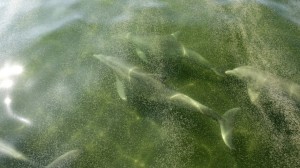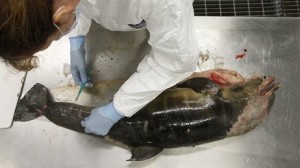Happy Fun Science Friday!
Though this post does not present such a happy story, given the recent discussion about dolphin photobombing, this week’s FSF is topically related. In the spring of 2010 the Deepwater Horizon oil rig experienced catastrophic failure resulting in the worst oil spill in human history. The Gulf of Mexico (GoM) was the unfortunate host of this catastrophe and the GoM community is still feeling the ecological, social, and economic consequences of this disaster.

Photo Credit: Alex Brandon/AP
One such impact that received little TV coverage during the spill was the uncharacteristic spike in dolphin deaths. A few months following the BP spill there was an unprecedented spike in dead dolphins washing ashore along the Gulf Coast; 67 dead dolphins by February of 2011, with more than half (35) of the dead dolphins being calves. This is in stark contrast to years preceding the spill when one or two dead dolphins per year were normally documented to wash ashore. Despite the spike in dolphin deaths, there was no definitive evidence linking the dead cetaceans to the oil spill as a number of other factors could have been responsible for the deaths, including infectious disease or the abnormally cold winter proceeding the spill.
However, recent work by Lori Schwacke, of the National Oceanic and Atmospheric Administration, and her colleagues, have for the first time confirmed that bottlenose dolphins are impacted by the BP oil spill. Their study showed that dolphins in Barataria Bay, Louisiana (an area heavily exposed to oil) were much sicker compared to those in Sarasota, Florida (an area not affected by the spill). Dolphins in Barataria had symptoms consistent with exposure to petroleum hydrocarbons; 25% were emaciated, they were 5 times more likely to have lung disease, and a number had severe tooth loss (a healthy dolphin has between 76 and 100 teeth).

Photo credit: Patrick Semansky/AP
As was stated from the study, “The severity of disease, poor body condition, and high prevalence of abnormalities seen in the [Barataria Bay, LA] dolphins is in stark contrast with the overall health status from the … reference site [Sarasota, FL], as well as with health conditions previously documented in bottlenose dolphins from other U.S. coastal sites.”
A grim reminder that despite the visual absence of BP oil in the GoM, the effects for the largest spill in history are still being felt.
Read the full article published in the journal of Environmental Science and Technology.
I feel compelled to state that one of my research grants is funded through money set aside by BP to do research in the Gulf of Mexico to assess impacts of the oil spill on that region.
I appreciate you keeping this subject in the public’s eye. Here in Texas, we never have a year where only one or two dolphins wash up, but since the DWH incident, we’ve had a constant unusual mortality event in marine mammals.
Its worth mentioning that dolphins are not all residential and that indivisuals and pods that get sick in and around the DWH spill zone may travel and wash up on the coasts of TX, LA, MS, AL or even FL. It’s important for us to get as much information from every standing and necropsy to fully measure the impact its had and will have. This is (unfortunately) far from over.
One nit-pick. Bottlenose dolphins (Tursiops truncatus) have between 76-100 teeth (most average about 88 [+/- 4] as adults), but we mave MANY more species of dolphin in the Gulf of Mexico and the average number of teeth they have can range from 6 – 200 depending upon which species it is. Kogia (not really a dolphin, but is a small toothed whale) can have 6 – 9 and Spinners (Genus Stenella) can have ~250. Again, I’m nit-picking, but I wanted it to be clear that tooth loss can be substantial on those with very few teeth to lose.
Nice job,
-DS
Thanks for your interest and comments. Your nitpicking was well received. 🙂